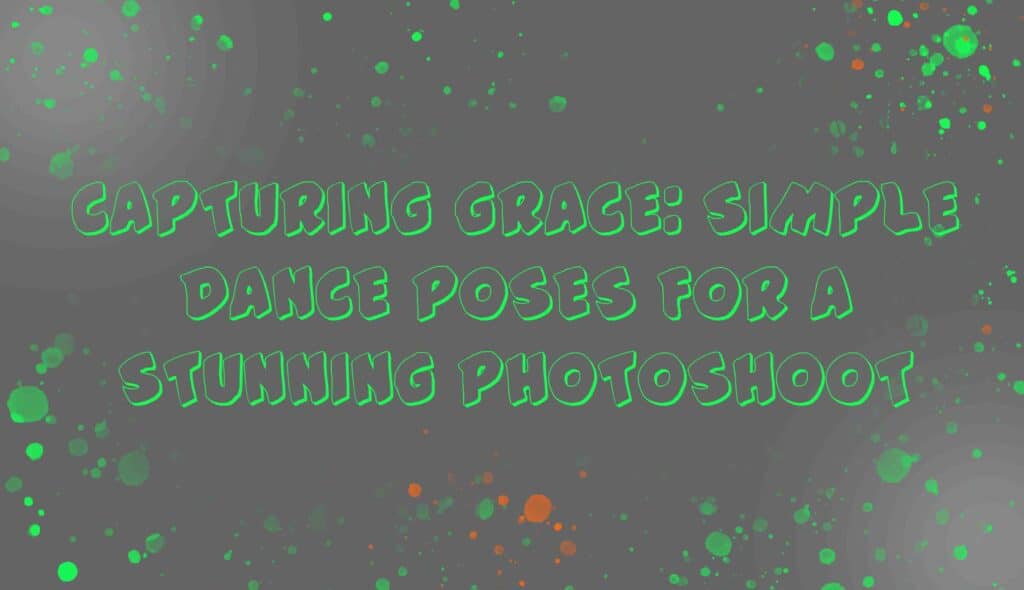Introduction
Dance is a captivating art form that combines fluid movements with expressive gestures. When captured through photography, it freezes those moments of grace, strength, and emotion. In this guide, we’ll explore a selection of simple yet dynamic dance poses that can elevate your photoshoot to a new level of beauty and artistry.
I. Preparation and Planning
A. Communication with the Dancer
Before the photoshoot, have a discussion with the dancer to understand their comfort level, style, and preferences. This will help tailor the poses to suit their abilities and showcase their unique strengths.
B. Location and Lighting
Choose a location with ample space to allow for movement. Natural light or soft diffused artificial light works best for capturing the fluidity of the dance.
II. Basic Dance Poses
A. Arabesque
- Description: This pose involves standing on one leg while extending the other leg straight behind you.
- Execution: The dancer lifts one leg behind them while keeping the torso upright and arms in a graceful position.
- Tips: Emphasize the extension of the raised leg and maintain a straight line from head to toe.
B. Plie
- Description: A foundational ballet position, the plie involves bending the knees while keeping the heels on the ground.
- Execution: The dancer bends their knees outward, keeping the heels in contact with the floor, and maintains an upright posture.
- Tips: Focus on the alignment of the knees over the toes and maintaining a straight back.
C. Attitude
- Description: In this pose, the dancer lifts one leg while bending it at a 90-degree angle.
- Execution: The dancer lifts and bends one leg to the side or back, creating a triangular shape with the body.
- Tips: Emphasize the height of the lifted leg and maintain a graceful upper body posture.
III. Dynamic Movement Poses
A. Pirouette
- Description: The pirouette is a graceful turning movement on one leg.
- Execution: The dancer starts in a plie position, then lifts one foot and turns on the supporting leg.
- Tips: Focus on spotting (fixing the gaze on a specific point) to maintain balance during the turn.
B. Jete
- Description: A jete is a dynamic leap or jump, often seen in ballet.
- Execution: The dancer leaps into the air, extending one leg forward and the other leg back, creating a split position.
- Tips: Emphasize the height of the jump and the extension of the legs.
C. Developpe
- Description: Developpe means to “unfold” in French. It involves smoothly unfolding the leg from a bent position to an extended one.
- Execution: The dancer starts with a bent leg and gradually extends it while keeping it elevated.
- Tips: Focus on controlled, fluid movement and maintaining a strong core for balance.
IV. Expressive Poses
A. Embrace
- Description: This pose involves two dancers embracing or holding hands in a graceful and expressive manner.
- Execution: The dancers face each other and create a harmonious connection through their arms and hands.
- Tips: Encourage the dancers to convey emotion through their facial expressions and body language.
B. Reaching Gesture
- Description: A reaching gesture conveys a sense of longing or aspiration.
- Execution: The dancer extends one arm gracefully, reaching towards a specific point.
- Tips: Focus on the line and form of the arm, and encourage the dancer to express emotion through their gaze.
V. Capturing the Perfect Shot
A. Camera Settings
- Shutter Speed: Use a fast shutter speed to freeze the motion of the dancer.
- Aperture: Choose a wide aperture (low f-number) to create a shallow depth of field, highlighting the dancer while blurring the background.
- ISO: Use a low ISO setting to maintain image quality and reduce noise.
B. Framing and Composition
Experiment with different angles, perspectives, and framing to capture the essence of the dance pose. Don’t be afraid to get close for intimate shots or step back for full-body compositions.
VI. Post-Processing and Editing
Use photo editing software to enhance colors, contrast, and sharpness. Pay attention to details like skin tone and lighting to bring out the best in your dance photos.
Conclusion: Dance as Art
Capturing dance poses in a photoshoot is a collaborative art form that requires a balance of technical skill and artistic expression. By understanding the fundamentals of dance poses and using them as a starting point, you can create stunning images that showcase the beauty and grace of dance. Remember to communicate with the dancer, plan your shots, and let your creativity flow. Happy photographing!
- What is Midjourney
 Discover the capabilities of Midjourney AI, learn how to effectively utilize the platform, and explore the advantages and disadvantages of the Midjourney AI image generator across its different pricing options.
Discover the capabilities of Midjourney AI, learn how to effectively utilize the platform, and explore the advantages and disadvantages of the Midjourney AI image generator across its different pricing options. - Brand identity elements
 In the vast marketing universe, imagery is pivotal in establishing and nurturing a brand’s identity. A brand’s visual choices are not merely aesthetic decisions but strategic moves that can significantly influence perception and performance. This Picfixs article explores the intricacies of selecting imagery that complements and enhances a brand’s essence, ensuring it resonates with the… Read more: Brand identity elements
In the vast marketing universe, imagery is pivotal in establishing and nurturing a brand’s identity. A brand’s visual choices are not merely aesthetic decisions but strategic moves that can significantly influence perception and performance. This Picfixs article explores the intricacies of selecting imagery that complements and enhances a brand’s essence, ensuring it resonates with the… Read more: Brand identity elements - 100 Best Mountain Captions and Mountain Quotes for Instagram
 Ready to scale new social media heights? Look no further than this treasure trove of 100 exhilarating captions and quotes, handpicked for your Instagram mountain posts!
Ready to scale new social media heights? Look no further than this treasure trove of 100 exhilarating captions and quotes, handpicked for your Instagram mountain posts! - Symmetry in Photography: A Creative Approach with Examples
 Delve into the enchanting realm of symmetry in photography as we showcase mesmerizing examples on our website. Experience the allure of perfectly mirrored images!
Delve into the enchanting realm of symmetry in photography as we showcase mesmerizing examples on our website. Experience the allure of perfectly mirrored images! - 11 Quarantine Photoshoot Ideas to Try at Home for Amazing Photos
 Looking for unique photoshoot ideas during quarantine? Explore the 11 creative suggestions that will help you capture unforgettable moments at home.
Looking for unique photoshoot ideas during quarantine? Explore the 11 creative suggestions that will help you capture unforgettable moments at home.


